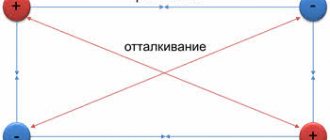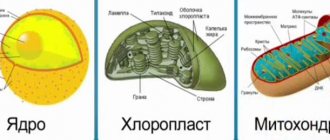§ 14. Hydrogen and oxygen compounds of non-metals
Chapter 3. General characteristics of non-metals- Give examples of formulas for higher oxygen and volatile hydrogen compounds of elements of the 3rd period. What atoms of elements are characterized by such hydrogen compounds?
Given at the bottom of the periodic table D.I. Mendeleev's general formulas of higher oxygen and volatile hydrogen compounds of elements of different groups reflect the forms of their compounds typical for these groups of elements. The concept of “form of compounds” was introduced into chemistry by D.I. Mendeleev.
General formulas reflect the composition of compounds typical of an entire group or subgroup of elements.
- Exercise.
Based on the general formulas of hydrogen and oxygen compounds of elements of the 3rd period, note the natural changes in the composition and properties of these compounds, as well as changes in the nature of the elements.
Non-metal elements, unlike metals, have gaseous hydrogen compounds .
Their composition depends on the oxidation state of the nonmetal
When considering the properties of volatile hydrogen compounds of nonmetals in accordance with their position in the periods of the periodic system, one can observe some general patterns in the change in their properties (polarity, solubility, the nature of hydrogen and oxygen compounds).
Thus, the polarity of molecules of gaseous hydrogen compounds in elements of the 3rd period increases with an increase in the OEO of atoms during the transition from group IV to VII, i.e., with a decrease in the negative oxidation state of the central atom: The
solubility of compounds in water and their acidity increase in the same order and strength.
You are already familiar with the good solubility of hydrogen chloride in water.
- Experience.
Let us once again turn to the well-known experiment of dissolving hydrogen chloride in water (see the chemistry textbook for grade 8). Let us remember that about 400 liters of hydrogen chloride dissolve in 1 liter of water. Water rushes forcefully into the rarefied space formed in the vessel and flows like a fountain, filling the bottle. Litmus added to an aqueous solution turns red, which proves the formation of acid.
Let's consider the essence of this process: hydrogen chloride molecules are polar, highly soluble in water and dissociate in it according to the equation:
- H2O + HCl = H3O+ + Cl-
When interacting with water, each hydrogen chloride molecule gives a proton (hydrogen cation) to the water molecule, which attaches to it via a donor-acceptor mechanism, forming a hydronium ion H3O+. The acidic properties of the hydrogen chloride solution depend on this ion (see § 5).
In periods from left to right, the acidic nature of hydrogen compounds of non-metals increases:
In A-groups, the polarity of molecules, the solubility and the basic nature of hydrogen compounds of non-metals in water, on the contrary, decrease when moving from top to bottom:
- NH3 → PH3 → AsH3
In relation to water, volatile hydrogen compounds of non-metals can be divided into three groups:
- highly soluble in water with dissociation into ions (HCl, HBr, HI, H2S, H2Se, NH3), exhibiting acidic or basic properties;
- water-degradable compounds. These include volatile hydrogen compounds of boron, silicon, and germanium. They undergo hydrolysis to form free hydrogen and acids:
- volatile hydrogen compounds of non-metals that do not interact with water (for example, phosphine is a hydrogen compound of phosphorus, methane is a hydrogen compound of carbon, etc.).
- BN3 + ZN2O = H3BO3 + ZN2
Gaseous hydrogen compounds inherent in p-elements of the main subgroups emphasize their non-metallic nature.
End of paragraph >>>
Chemistry lesson notes with presentation, 9th grade. Hydrogen compounds of nonmetals
Chemistry lesson, 9th grade
Author: Elena Vladimirovna Gudoshnikova, chemistry teacher of the Moscow Municipal Educational Institution Lyceum in the town of Krasnaya Polyana, Vyatskopolyansky district, Kirov region Subject: chemistry. Grade: 9. Lesson type: combined. Topic: hydrogen compounds of nonmetals. Purpose: to study the composition and properties of hydrogen compounds of non-metals. Tasks. Educational:
1).
During the lesson, ensure the assimilation of the following basic chemical concepts on the topic of the lesson: hydrogen compounds of non-metals, types of chemical bonds, types of crystal lattice, nature of compounds of non-metals 2). Continue developing skills in working with the textbook, periodic tables and solubility. 3). Continue to develop special skills in the subject of chemistry (compose chemical formulas and equations, work with laboratory equipment and reagents). Developmental:
1).
To develop in students the ability to highlight the main, essential things in the material being studied, to compare, contrast, generalize, systematize, and present their thoughts compactly and logically. 2). Develop student independence 3). Develop the emotions and motives of students by creating emotional and motivational situations in the lesson. 4). Develop the abilities, inclinations, cognitive interest, motives and needs of students using game situations, educational discussions, using data on the use of the studied chemical objects in the outside world, on news of chemical science and technology. Educational:
To promote during the lesson the formation of the following ideological ideas: 1) objectivity and reality of the surrounding world, 2) cause-and-effect and other connections between phenomena, 3) continuity of changes and development in nature and society, 4) conditionality of the development of chemical science by the needs of production, life and everyday life, 5) the truth of scientific knowledge and laws of nature.
Universal learning activities. Personal learning activities:
personal self-determination, establishing a connection between the goal of educational activity and its motive, assessing the content being learned.
Regulatory UUD:
goal setting, planning, predicting the reaction of a solution depending on the composition of the salt undergoing hydrolysis, control in the form of comparison of the result with a standard, assessment - highlighting and awareness by students of what has been learned and what still needs to be learned, awareness of the quality and level of assimilation, assessment work results.
Communicative learning activities:
planning educational cooperation with the teacher and peers, conflict resolution - identifying, identifying problems, searching and evaluating alternative ways to resolve conflict, managing the behavior of a partner in a group - monitoring, correction, evaluation of his actions.
Cognitive UUD:
structuring knowledge about the composition, nature and properties of hydrogen compounds of non-metals;
setting and formulating a problem, putting forward a hypothesis and its justification, building a logical chain of reasoning, analyzing an experiment:; ability to draw conclusions, reflection on methods and conditions of action, control and assessment of skills in writing reaction equations confirming the nature of hydrogen compounds of non-metals Planned results. Subject:
• Know: the oxidation states of non-metals in hydrogen compounds, the nature and properties of hydrogen compounds of non-metals • Be able to: draw up formulas for hydrogen compounds of non-metals based on the oxidation state, determine the nature of hydrogen compounds of non-metals.
Confirm character by writing appropriate equations of reactions Personal:
• formation of a holistic worldview that corresponds to the modern level of development of science • Formation of a conscious, respectful and friendly attitude towards another person, • mastering social norms, rules of behavior, • formation of communicative competence in communication and cooperation with peers and adults in the process of educational activities;
Meta-subject:
• The ability to define concepts, establish cause-and-effect relationships, build logical reasoning, and draw conclusions;
• Ability to use signs and symbols to solve educational problems; • Semantic reading; • Ability to organize educational cooperation and joint activities with the teacher and peers; Basic concepts: oxidation state, chemical bond, electronegativity, bond length, hydrogen compounds, properties (acidic, basic, amphoteric, inert). Interdisciplinary connections: biology, physics Resources: Basic
1).
Kuznetsova N.E., Titova I.M., Gara N.N. Series Line UMK N. E. Kuznetsova. Chemistry 9 - M.: Ventana-Graf, 2012 2). Tables: periodic table of chemical elements D.I. Periodic table, solubility table 3). Presentation for the lesson. 4). Natural objects: plasticine, matches, solutions of hydrogen chloride, ammonia, universal indicator, glass slides. Additional
1).
Chemistry. Multimedia textbook for new education, - M.: Education, 2007 2). Educational collection. 8-9 grade. Chemistry. basic level, -M.: Education, 2007 Lesson forms: frontal, individual, pair. Technology: a lesson in learning new knowledge.
During the classes.
1. Organizational moment. Greetings. Teacher's activities. Announces the topic and lesson plan. (Slide 1). Student activities. Write down the topic of the lesson in your notebook. 2. Checking homework. Teacher's activities. Distributes task cards to students (6 people), checks, corrects, evaluates. Card. Describe the element - non-metal, using the periodic table. Describe the simple substance formed by this element according to the plan: chemical formula. Type of connection, type of lattice. Physical properties, chemical properties. Confirm your answer by writing reaction equations. It is necessary to characterize carbon, oxygen, phosphorus, sulfur, chlorine, iodine. Student activities. Write down chemical formulas and equations, recite information using basic terms on the topic. In parallel with preparing students at the blackboard, the teacher conducts a frontal survey of students about the structure of atoms of elements - non-metals. 3. Studying new material. Working with plasticine. Teacher's activities. Shows a slide with the task: “Given the formulas of the substances NH3, HI, H2S, CH4. Determine the valencies of the elements. Make models of molecules from plasticine and matches” (slide 2), monitors the task and makes corrections. Pays attention to the color scheme of the model, the size of the atomic models, and the number of matches used. Asks for an explanation. Corrects, selectively evaluates. Student activities. The valencies of elements are determined. They work in pairs with plasticine. Carry out a check. (Slide 3). Teacher's activities. Shows a slide with tasks: “Determine the type of bond in the molecules of hydrogen compounds of non-metals. Compare the bond lengths in the molecules of hydrogen compounds of non-metals. Type of crystal lattice of hydrogen compounds of non-metals." (Slide 4). Student activities. Complete tasks. Correct their knowledge. Laboratory experience. Teacher's activities. Shows a slide with tasks: “Examine solutions of ammonia and hydrogen chloride with a universal indicator. Explain the results” (slide 5), observes the activities of students, controls. Student activities. In pairs they conduct experiments, observe, compare, and explain the results. Working with the textbook. Teacher's activities. Shows a slide with the task: “Find information in the textbook about changes in the properties of hydrogen compounds of non-metals in the period, in the main subgroups” (textbook: page 63, paragraph 14), controls the students’ activities. Student activities. Students work with the textbook, read meaningfully, choose an answer to a question, and write in a notebook. 4. Consolidation of new material. Teacher's activities. Conducts a frontal conversation with students. Questions. 1). What are the formulas of hydrogen compounds of group 7A nonmetals. 2). What is the nature of hydrogen compounds of group 7A nonmetals? 3). How to experimentally confirm the nature of the connection. Next, he offers students a written task: “Write the equation for the reaction of hydrogen iodide with potassium hydroxide in molecular and ionic form” (slide 7), observes the implementation, corrects, and selectively evaluates. Student activities. Answer questions. Write reaction equations using the periodic table. 5. Control. Teacher's activities. Shows a slide with test questions (slide 8), observes the completion of the task. Test 1). In a compound whose formula is NH3, the oxidation state of the second element is: a) -3 b) -2 c) +3 2). The bond in the NH3 molecule is: a) ionic b) nonpolar covalent c) polar covalent 3). Type of NH3 crystal lattice: a) atomic b) molecular c) ionic 4). A compound with the formula NH3 has the following character: a) acidic b) basic c) amphoteric Student activity. They read the test questions meaningfully, choose the correct answers, and exercise self-control (slide 9). 6. Reflection. Teacher's activities.
Invites students to write a “telegram” (slide 10), observes the completion of the task, and selectively evaluates. Student activities. They send and receive a “telegram”, working in pairs. Recording homework. Teacher's activities. Shows a slide with homework and speaks it out. (Slide 11). Student activities. Write down homework in diaries: textbook paragraph 14 pp. 62-64 teach. Presentation on the topic: hydrogen compounds of non-metals
We recommend watching:
Chemistry lesson notes, grade 9. Oxygen compounds of carbon Synopsis of a chemistry lesson for grade 9. Sulfuric acid Methodological development of a chemistry lesson summary with a presentation in grade 9 at the Mining Museum Chemistry lesson summary with a presentation, grade 9. Repetition on topic: Metals
Similar articles:
Methodological development of a chemistry lesson, grade 9
Chemistry lesson notes for grade 9
Practical work in chemistry grade 9
Game - competition in chemistry in 9th grade
Chemistry quiz with answers for 9th grade
Non-metal oxides
- non-salt-forming oxides: SiO, N2O, NO, CO;
- salt-forming oxides (acid oxides) - all other non-metal oxides: gases: SO2, CO2, NO2, etc.;
- liquids: SO3, N2O3, etc.;
- solids: P2O5, SiO2 (the only water-soluble acid oxide).
Acidic oxides are anhydrides of acids, for example, P2O5 is the anhydride of the acid H3PO4.
When acidic oxides are dissolved in water, hydroxides are formed, which are acids:
N2+5O5+H2O = 2HN+5O3
If a nonmetal forms several oxygen-containing acids, then with an increase in the oxidation state of the nonmetal, the strength of the acid also increases:
H2S+4O3 H2S+6O4 The second acid is stronger



